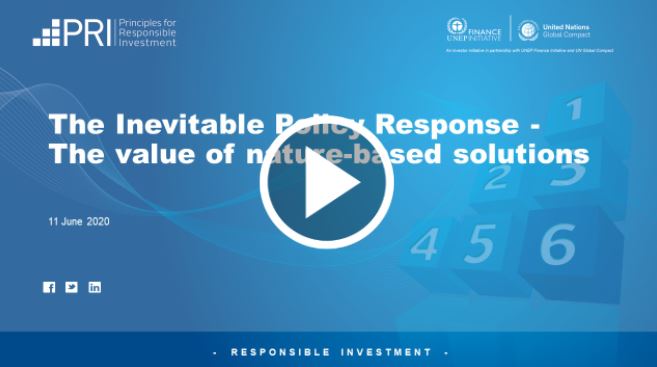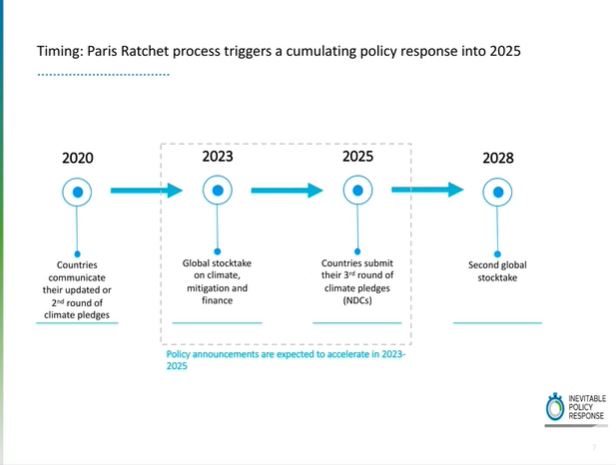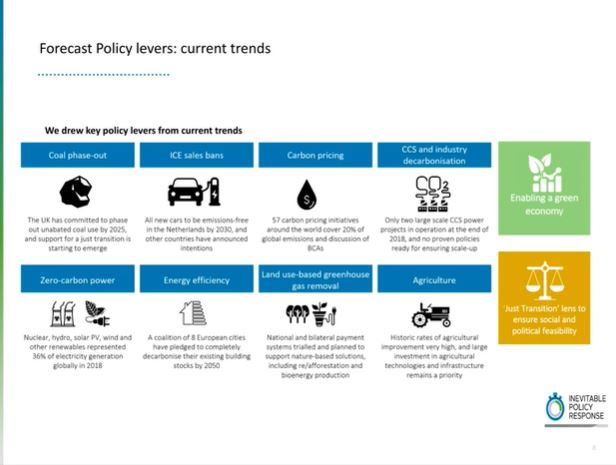Discover and read the best of Twitter Threads about #afforestation
Most recents (11)
🚨NEW STUDY🚨
"Six models are used in a recent study to analyze the climatic, environmental & socio-economic consequences of #overshooting a C budget consistent with the 1.5°C temp target along the cause-effect chain from emissions & #CarbonRemovals to climate risks & impact."
🧵
"Six models are used in a recent study to analyze the climatic, environmental & socio-economic consequences of #overshooting a C budget consistent with the 1.5°C temp target along the cause-effect chain from emissions & #CarbonRemovals to climate risks & impact."
🧵

"Global climatic indicators such as CO2-concentration and mean temperature closely follow the #CarbonBudget #overshoot with mid-century peaks of 50 ppmv and 0.35°C, respectively."
2/10
2/10
Findings of this study highlight that "investigating #overshoot scenarios requires temporally and spatially differentiated analysis of climate, environmental and socioeconomic systems."
3/10
3/10
✍️ 𝐖𝐞𝐞𝐤𝐥𝐲 𝐇𝐢𝐠𝐡𝐥𝐢𝐠𝐡𝐭𝐬 ✍️
Top #CarbonDioxideRemoval News /Scientific papers from the past week covered in a 🧵below: ⬇️
🌱🎛️🪨🌊
1/15
Top #CarbonDioxideRemoval News /Scientific papers from the past week covered in a 🧵below: ⬇️
🌱🎛️🪨🌊
1/15

1️⃣ 🌊"Dalhousie receives historic $154‑million investment to study the ocean’s pivotal role in climate change. The 𝐥𝐚𝐫𝐠𝐞𝐬𝐭 𝐫𝐞𝐬𝐞𝐚𝐫𝐜𝐡 𝐠𝐫𝐚𝐧𝐭 in Dalhousie history"!
@planetary_tech
#OceanAlkalinityEnhancement
➡️
2/15
@planetary_tech
#OceanAlkalinityEnhancement
➡️
2/15
2️⃣ 🚜🌾"The Carbon Business Council (@CO2Council) released a policy brief on #CarbonRemoval and the #2023FarmBill."
➡️
3/15
➡️
3/15
🚨NEW STUDY🚨
"#Afforestation & #reforestation are worthwhile solutions for C sequestration, but lack of hierarchical spatial-temporal maps for national scale #CarbonSequestrationRate hinders scientific implementation."
In this regard, a new study is published, details ⬇️
1/8🧵
"#Afforestation & #reforestation are worthwhile solutions for C sequestration, but lack of hierarchical spatial-temporal maps for national scale #CarbonSequestrationRate hinders scientific implementation."
In this regard, a new study is published, details ⬇️
1/8🧵

🌲Researchers assessed "the spatial-temporal #CarbonSequestrationRate (CSR) per area for #Afforestation & #Reforestation at the provincial, prefectural, and county levels in China using a forest carbon sequestration model under three climate scenarios."
2/8
2/8
🌳🌱Results showed that "the #CSR of vegetation (CSRVeg), soil (CSRSoil), and the ecosystem (CSREco) significantly varied across space and time. In China, the CSRVeg, CSRSoil, and CSREco were primarily regulated by the spatial variations in temperature and precipitation."
3/8
3/8
🚨𝐅𝐨𝐫 #𝐂𝐃𝐑 𝐅𝐨𝐥𝐤𝐬!🚨
ICYM any recent developments in the field of #CarbonDioxideRemoval published btw 𝐉𝐚𝐧𝐮𝐚𝐫𝐲 𝟐𝟎𝟐𝟑 & 𝐀𝐩𝐫𝐢𝐥 𝟐𝟎𝟐𝟑, here are links to (in🧵⬇️) all pertinent research papers, news articles, reports, thesis, event recordings, & podcasts ⬇️
ICYM any recent developments in the field of #CarbonDioxideRemoval published btw 𝐉𝐚𝐧𝐮𝐚𝐫𝐲 𝟐𝟎𝟐𝟑 & 𝐀𝐩𝐫𝐢𝐥 𝟐𝟎𝟐𝟑, here are links to (in🧵⬇️) all pertinent research papers, news articles, reports, thesis, event recordings, & podcasts ⬇️

🚨PAPER🚨
"Many scenario analyses suggest that #NegativeEmissionTechnologies, such as #bioenergy with carbon capture and storage & #afforestation, are required to achieve #NetZero target, but their large-scale deployment has a trade-off relationship with food security."
🧵
1/7
"Many scenario analyses suggest that #NegativeEmissionTechnologies, such as #bioenergy with carbon capture and storage & #afforestation, are required to achieve #NetZero target, but their large-scale deployment has a trade-off relationship with food security."
🧵
1/7

So, a new study considered an innovative #NET, "direct air carbon capture and storage (#DACCS), and analyzed its impact on global food access based on an indicator defined by food expenditure per GDP."
2/7
2/7
Study found that "the scenario considering DACCS mitigates the adverse impact on food access in regions such as Sub-Saharan Africa compared to the scenario not considering #DACCS by alleviating food expenditure increase & GDP loss associated with emission reduction efforts."
3/7
3/7
📝💡 𝐖𝐞𝐞𝐤𝐥𝐲 𝐇𝐢𝐠𝐡𝐥𝐢𝐠𝐡𝐭𝐬💡📝
Here's is your roundup of top #CarbonDioxideRemoval News Articles / Scientific Papers from the past week: 🌱🪨🎛️🌊
🧵
1/16
Here's is your roundup of top #CarbonDioxideRemoval News Articles / Scientific Papers from the past week: 🌱🪨🎛️🌊
🧵
1/16
1️⃣ @ebbcarbon raises $20 million Series A, "the largest #investment in ocean-based #CarbonRemoval technology to date." 🌊
➡️
2/16
➡️
2/16
2️⃣ @running_tide announced its initial Framework Protocol for #OceanCarbonRemoval. "This is the first carbon removal project utilizing a “fast-to-slow” framework for carbon removal accounting." 🌊
➡️
3/16
➡️
3/16
1/3 #VoluntaryCarbonMarket price drops 35% in 2 weeks due to media reports casting doubt on #REDD+ projects' efficacy in reducing emissions. Market confidence needs to be restored for demand to pick up.
2/3 Carbon credit buyers expected to request more supporting docs to verify quality. Market interests may shift from emission avoidance to removal projects with fewer risks and better quality credits.
3/3 #Afforestation and tech-based carbon capture & storage projects may see an increase in market demand as #EmissionRemoval projects gain popularity. #CarbonTrading #CarbonCredit
If you ever wanted to acquire #carbonoffsets, you've surely faced the question of categorization. Here is an easy taxonomy 👇 🧵
1/ Two weeks ago I highlighted the difference between carbon emission reduction and removal projects.
The idea of #CarbonReduction is to pay others to reduce emissions in your place. But your output remains in the system. One plus zero.
The idea of #CarbonReduction is to pay others to reduce emissions in your place. But your output remains in the system. One plus zero.
2/ #CarbonRemoval on the other hand scrubs carbon directly from the atmosphere. Plus one, minus one.
But technically, the #carbonmarket makes no difference. A ton is a ton.
But technically, the #carbonmarket makes no difference. A ton is a ton.
Thanks to everyone who shared my article. Seems like it was read widely. Here is a thread on some of the resources/materials I referred to and which provide more context esp. on tree planting/afforestation in India. Plus a few comments I received... thread... 1/n
A good place to start is this paper on the Pitfalls of Tree Planting by @ForrestFleisch1 @this_is_divya and others. Well argued and worth reading... 2/n
academic.oup.com/bioscience/art…
academic.oup.com/bioscience/art…
Much research + scientists have pointed out why planting trees in non-forest ecosystems such as grasslands and savannas is a bad idea. Here's a great paper
Savannahs of Asia: antiquity, biogeography, and an uncertain future by Jayashree Ratnam et al
doi.org/10.1098/rstb.2… 3/n
Savannahs of Asia: antiquity, biogeography, and an uncertain future by Jayashree Ratnam et al
doi.org/10.1098/rstb.2… 3/n

#carbonneutral after 2030 is too late, find out why:
SR 1.5 recommended we stay below 1.5ºC by 2100, yet oddly allowed for overshoot pathways. An overshoot would cost us in biodiversity and global food security, as well as further weaken the climate by accelerating warming past more tipping elements. 

To avoid hitting more tipping elements, we need to switch from fossil fuels to renewables asap, increase energy efficiency, & deploy more renewable power. All the while increase DAC R&D. Tons of room for innovation here! IEA is already planing iea.li/2VQB0Pn
#SriAgenda abt to start 🔔 #June11 at 4pm CEST
The #InevitablePolicyResponse - The value of #NatureBasedSolutions "@PRI_News @VividEconomics
brighttalk.com/webcast/17701/…
#sustainablefinance #sri #esg #responsibleinvestment @andytuit @SRI_Natives @CsrEvent
The #InevitablePolicyResponse - The value of #NatureBasedSolutions "@PRI_News @VividEconomics
brighttalk.com/webcast/17701/…
#sustainablefinance #sri #esg #responsibleinvestment @andytuit @SRI_Natives @CsrEvent

@PRI_News @VividEconomics @andytuit @SRI_Natives @CsrEvent #SriAgenda just started 💥
#InevitablePolicyResponse #NatureBasedSolutions



#InevitablePolicyResponse #NatureBasedSolutions




@PRI_News @VividEconomics @andytuit @SRI_Natives @CsrEvent there's a clear nexus btw #publichealth, #deforestation and #climatechange, says Sagarita Chatterjee from @PRI_News in her opening remarks, and our key message to investors is: ACT NOW, she says
#InevitablePolicyResponse #NatureBasedSolutions #climatecrisis #sustainablefinance


#InevitablePolicyResponse #NatureBasedSolutions #climatecrisis #sustainablefinance





